Public Health Report: Addressing HIV/AIDS in Quezon City, Philippines
VerifiedAdded on 2023/03/31
|14
|3515
|271
Report
AI Summary
This report provides a comprehensive analysis of the HIV/AIDS situation in Quezon City, Philippines. It begins with an executive summary and an introduction that outlines the city's demographic and health context, highlighting the increasing prevalence of HIV/AIDS. The report delves into the health issue, discussing various factors contributing to the high infection rates, including socioeconomic conditions, lack of knowledge, religious beliefs, and risky sexual behaviors. It then explores the health setting approach, offering recommendations for addressing the issue through interventions such as workshops, training programs, and policy changes, all aimed at improving public health outcomes. The report concludes by summarizing the key findings and emphasizing the need for concerted efforts to combat the spread of HIV/AIDS in Quezon City.

Running head: AIDS IN QUEZON CITY
AIDS in Quezon City
Name of the Student
Name of the University
Author Note
AIDS in Quezon City
Name of the Student
Name of the University
Author Note
Paraphrase This Document
Need a fresh take? Get an instant paraphrase of this document with our AI Paraphraser
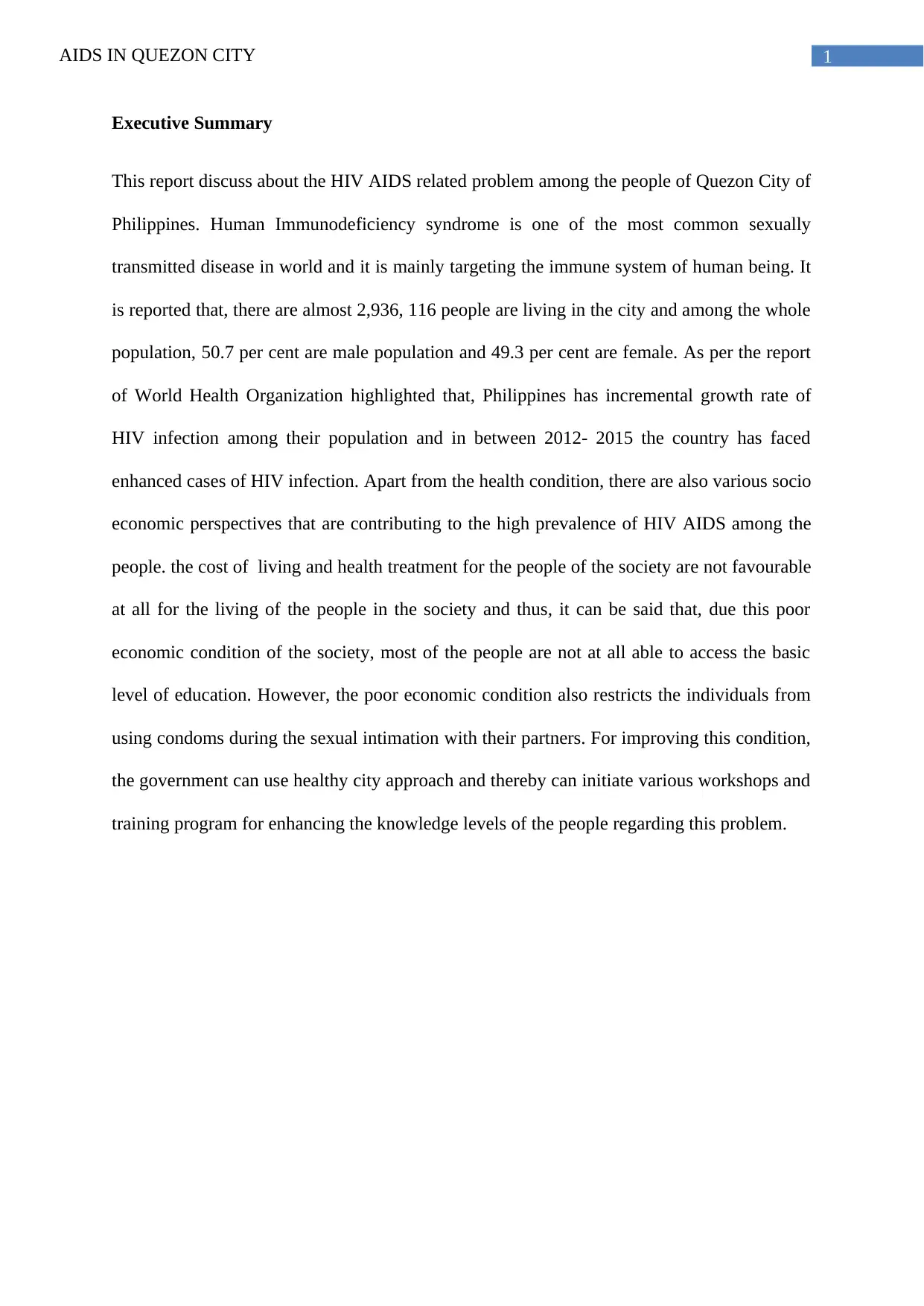
1AIDS IN QUEZON CITY
Executive Summary
This report discuss about the HIV AIDS related problem among the people of Quezon City of
Philippines. Human Immunodeficiency syndrome is one of the most common sexually
transmitted disease in world and it is mainly targeting the immune system of human being. It
is reported that, there are almost 2,936, 116 people are living in the city and among the whole
population, 50.7 per cent are male population and 49.3 per cent are female. As per the report
of World Health Organization highlighted that, Philippines has incremental growth rate of
HIV infection among their population and in between 2012- 2015 the country has faced
enhanced cases of HIV infection. Apart from the health condition, there are also various socio
economic perspectives that are contributing to the high prevalence of HIV AIDS among the
people. the cost of living and health treatment for the people of the society are not favourable
at all for the living of the people in the society and thus, it can be said that, due this poor
economic condition of the society, most of the people are not at all able to access the basic
level of education. However, the poor economic condition also restricts the individuals from
using condoms during the sexual intimation with their partners. For improving this condition,
the government can use healthy city approach and thereby can initiate various workshops and
training program for enhancing the knowledge levels of the people regarding this problem.
Executive Summary
This report discuss about the HIV AIDS related problem among the people of Quezon City of
Philippines. Human Immunodeficiency syndrome is one of the most common sexually
transmitted disease in world and it is mainly targeting the immune system of human being. It
is reported that, there are almost 2,936, 116 people are living in the city and among the whole
population, 50.7 per cent are male population and 49.3 per cent are female. As per the report
of World Health Organization highlighted that, Philippines has incremental growth rate of
HIV infection among their population and in between 2012- 2015 the country has faced
enhanced cases of HIV infection. Apart from the health condition, there are also various socio
economic perspectives that are contributing to the high prevalence of HIV AIDS among the
people. the cost of living and health treatment for the people of the society are not favourable
at all for the living of the people in the society and thus, it can be said that, due this poor
economic condition of the society, most of the people are not at all able to access the basic
level of education. However, the poor economic condition also restricts the individuals from
using condoms during the sexual intimation with their partners. For improving this condition,
the government can use healthy city approach and thereby can initiate various workshops and
training program for enhancing the knowledge levels of the people regarding this problem.

2AIDS IN QUEZON CITY
Table of Contents
Introduction................................................................................................................................3
Health Issue................................................................................................................................4
Health Setting Approach and Recommendation........................................................................7
Conclusion..................................................................................................................................9
Table of Contents
Introduction................................................................................................................................3
Health Issue................................................................................................................................4
Health Setting Approach and Recommendation........................................................................7
Conclusion..................................................................................................................................9
⊘ This is a preview!⊘
Do you want full access?
Subscribe today to unlock all pages.

Trusted by 1+ million students worldwide
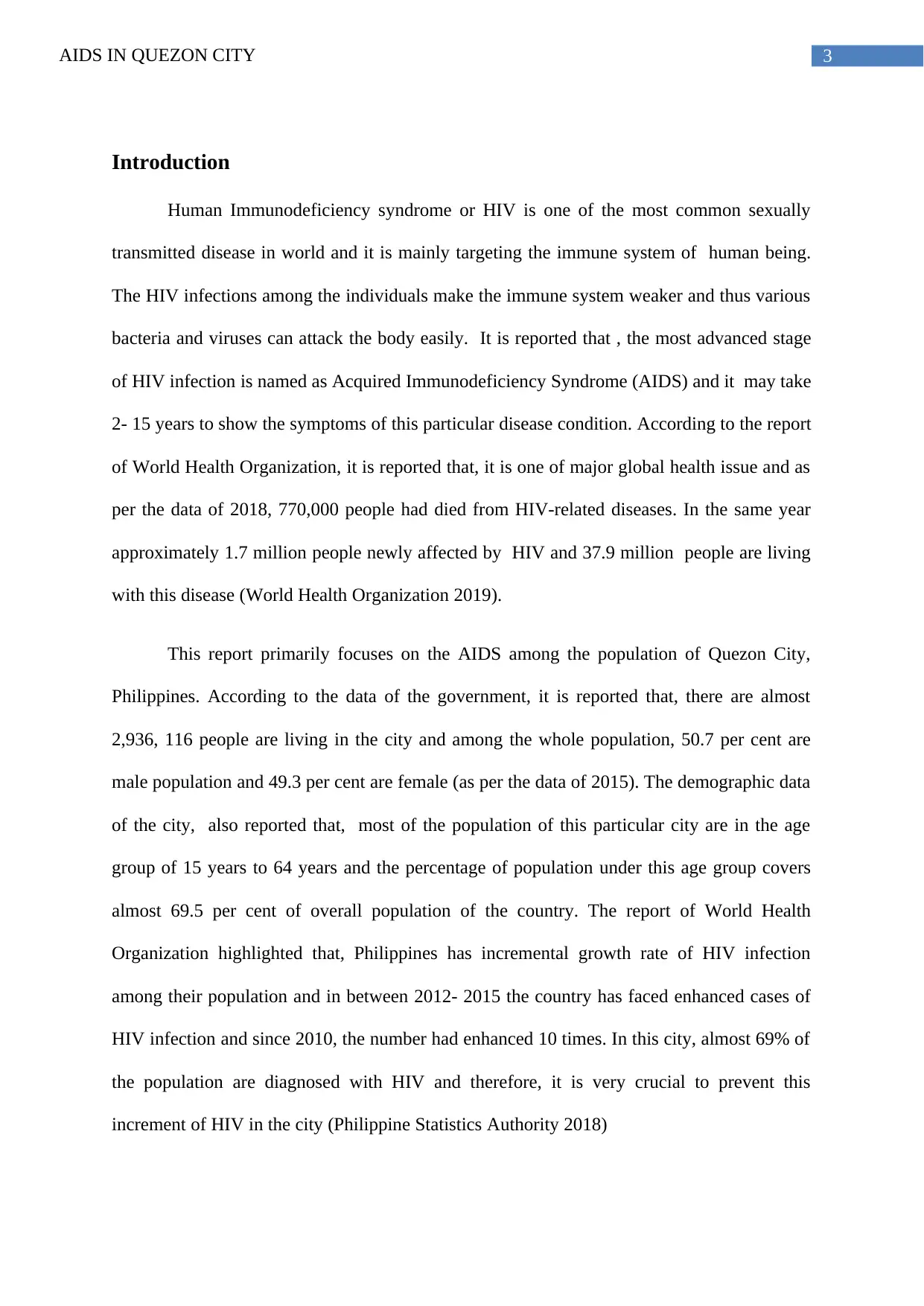
3AIDS IN QUEZON CITY
Introduction
Human Immunodeficiency syndrome or HIV is one of the most common sexually
transmitted disease in world and it is mainly targeting the immune system of human being.
The HIV infections among the individuals make the immune system weaker and thus various
bacteria and viruses can attack the body easily. It is reported that , the most advanced stage
of HIV infection is named as Acquired Immunodeficiency Syndrome (AIDS) and it may take
2- 15 years to show the symptoms of this particular disease condition. According to the report
of World Health Organization, it is reported that, it is one of major global health issue and as
per the data of 2018, 770,000 people had died from HIV-related diseases. In the same year
approximately 1.7 million people newly affected by HIV and 37.9 million people are living
with this disease (World Health Organization 2019).
This report primarily focuses on the AIDS among the population of Quezon City,
Philippines. According to the data of the government, it is reported that, there are almost
2,936, 116 people are living in the city and among the whole population, 50.7 per cent are
male population and 49.3 per cent are female (as per the data of 2015). The demographic data
of the city, also reported that, most of the population of this particular city are in the age
group of 15 years to 64 years and the percentage of population under this age group covers
almost 69.5 per cent of overall population of the country. The report of World Health
Organization highlighted that, Philippines has incremental growth rate of HIV infection
among their population and in between 2012- 2015 the country has faced enhanced cases of
HIV infection and since 2010, the number had enhanced 10 times. In this city, almost 69% of
the population are diagnosed with HIV and therefore, it is very crucial to prevent this
increment of HIV in the city (Philippine Statistics Authority 2018)
Introduction
Human Immunodeficiency syndrome or HIV is one of the most common sexually
transmitted disease in world and it is mainly targeting the immune system of human being.
The HIV infections among the individuals make the immune system weaker and thus various
bacteria and viruses can attack the body easily. It is reported that , the most advanced stage
of HIV infection is named as Acquired Immunodeficiency Syndrome (AIDS) and it may take
2- 15 years to show the symptoms of this particular disease condition. According to the report
of World Health Organization, it is reported that, it is one of major global health issue and as
per the data of 2018, 770,000 people had died from HIV-related diseases. In the same year
approximately 1.7 million people newly affected by HIV and 37.9 million people are living
with this disease (World Health Organization 2019).
This report primarily focuses on the AIDS among the population of Quezon City,
Philippines. According to the data of the government, it is reported that, there are almost
2,936, 116 people are living in the city and among the whole population, 50.7 per cent are
male population and 49.3 per cent are female (as per the data of 2015). The demographic data
of the city, also reported that, most of the population of this particular city are in the age
group of 15 years to 64 years and the percentage of population under this age group covers
almost 69.5 per cent of overall population of the country. The report of World Health
Organization highlighted that, Philippines has incremental growth rate of HIV infection
among their population and in between 2012- 2015 the country has faced enhanced cases of
HIV infection and since 2010, the number had enhanced 10 times. In this city, almost 69% of
the population are diagnosed with HIV and therefore, it is very crucial to prevent this
increment of HIV in the city (Philippine Statistics Authority 2018)
Paraphrase This Document
Need a fresh take? Get an instant paraphrase of this document with our AI Paraphraser
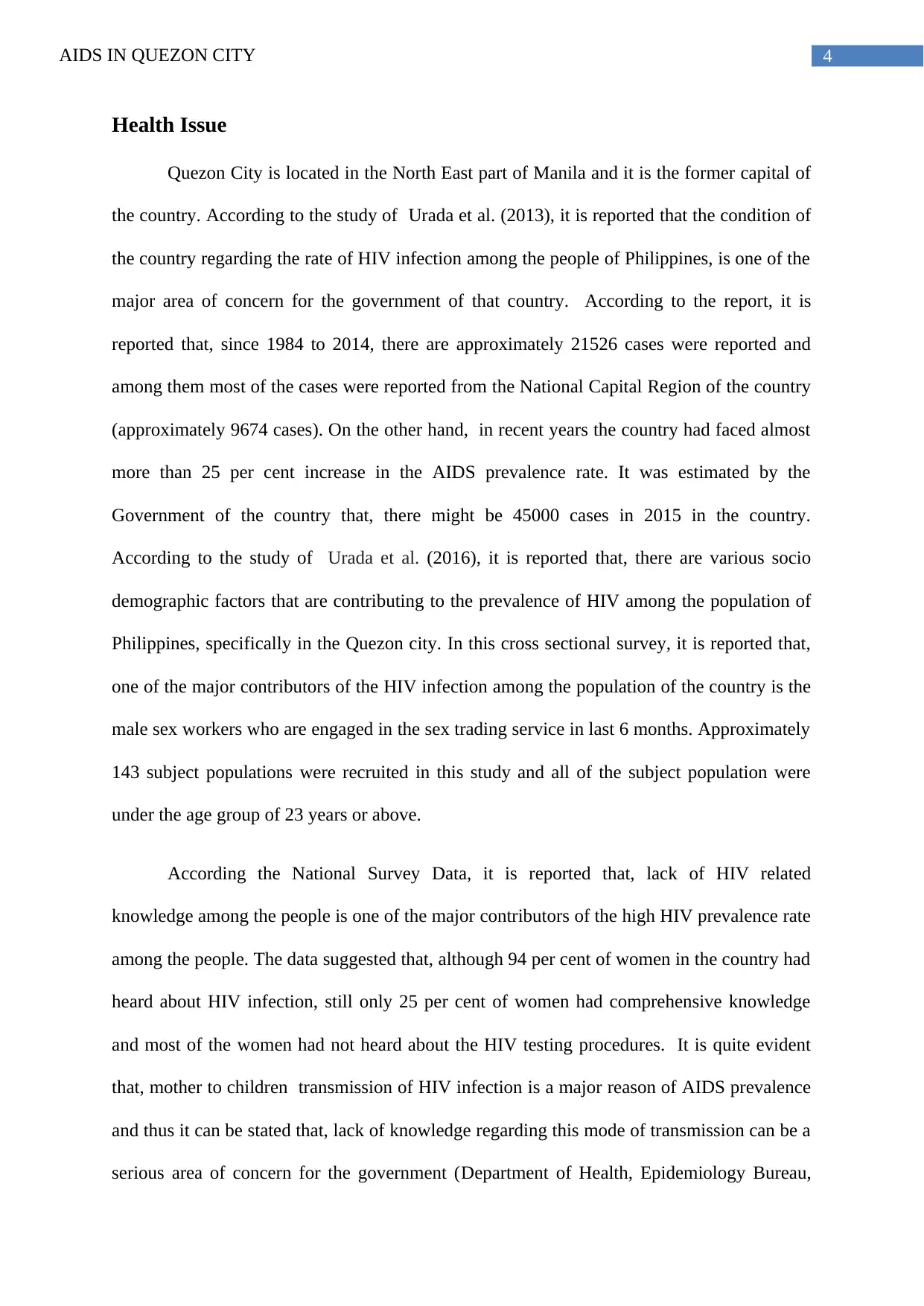
4AIDS IN QUEZON CITY
Health Issue
Quezon City is located in the North East part of Manila and it is the former capital of
the country. According to the study of Urada et al. (2013), it is reported that the condition of
the country regarding the rate of HIV infection among the people of Philippines, is one of the
major area of concern for the government of that country. According to the report, it is
reported that, since 1984 to 2014, there are approximately 21526 cases were reported and
among them most of the cases were reported from the National Capital Region of the country
(approximately 9674 cases). On the other hand, in recent years the country had faced almost
more than 25 per cent increase in the AIDS prevalence rate. It was estimated by the
Government of the country that, there might be 45000 cases in 2015 in the country.
According to the study of Urada et al. (2016), it is reported that, there are various socio
demographic factors that are contributing to the prevalence of HIV among the population of
Philippines, specifically in the Quezon city. In this cross sectional survey, it is reported that,
one of the major contributors of the HIV infection among the population of the country is the
male sex workers who are engaged in the sex trading service in last 6 months. Approximately
143 subject populations were recruited in this study and all of the subject population were
under the age group of 23 years or above.
According the National Survey Data, it is reported that, lack of HIV related
knowledge among the people is one of the major contributors of the high HIV prevalence rate
among the people. The data suggested that, although 94 per cent of women in the country had
heard about HIV infection, still only 25 per cent of women had comprehensive knowledge
and most of the women had not heard about the HIV testing procedures. It is quite evident
that, mother to children transmission of HIV infection is a major reason of AIDS prevalence
and thus it can be stated that, lack of knowledge regarding this mode of transmission can be a
serious area of concern for the government (Department of Health, Epidemiology Bureau,
Health Issue
Quezon City is located in the North East part of Manila and it is the former capital of
the country. According to the study of Urada et al. (2013), it is reported that the condition of
the country regarding the rate of HIV infection among the people of Philippines, is one of the
major area of concern for the government of that country. According to the report, it is
reported that, since 1984 to 2014, there are approximately 21526 cases were reported and
among them most of the cases were reported from the National Capital Region of the country
(approximately 9674 cases). On the other hand, in recent years the country had faced almost
more than 25 per cent increase in the AIDS prevalence rate. It was estimated by the
Government of the country that, there might be 45000 cases in 2015 in the country.
According to the study of Urada et al. (2016), it is reported that, there are various socio
demographic factors that are contributing to the prevalence of HIV among the population of
Philippines, specifically in the Quezon city. In this cross sectional survey, it is reported that,
one of the major contributors of the HIV infection among the population of the country is the
male sex workers who are engaged in the sex trading service in last 6 months. Approximately
143 subject populations were recruited in this study and all of the subject population were
under the age group of 23 years or above.
According the National Survey Data, it is reported that, lack of HIV related
knowledge among the people is one of the major contributors of the high HIV prevalence rate
among the people. The data suggested that, although 94 per cent of women in the country had
heard about HIV infection, still only 25 per cent of women had comprehensive knowledge
and most of the women had not heard about the HIV testing procedures. It is quite evident
that, mother to children transmission of HIV infection is a major reason of AIDS prevalence
and thus it can be stated that, lack of knowledge regarding this mode of transmission can be a
serious area of concern for the government (Department of Health, Epidemiology Bureau,
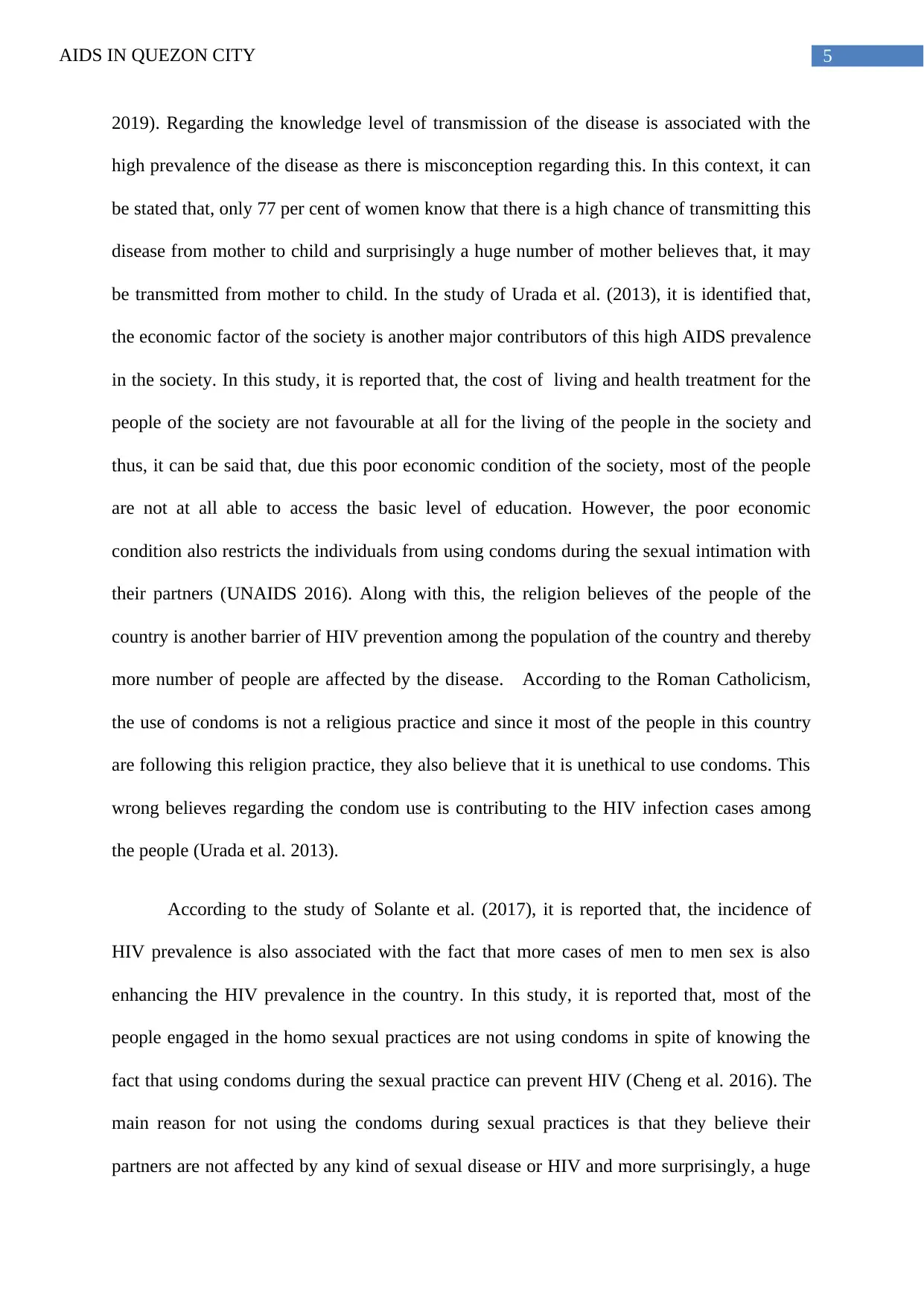
5AIDS IN QUEZON CITY
2019). Regarding the knowledge level of transmission of the disease is associated with the
high prevalence of the disease as there is misconception regarding this. In this context, it can
be stated that, only 77 per cent of women know that there is a high chance of transmitting this
disease from mother to child and surprisingly a huge number of mother believes that, it may
be transmitted from mother to child. In the study of Urada et al. (2013), it is identified that,
the economic factor of the society is another major contributors of this high AIDS prevalence
in the society. In this study, it is reported that, the cost of living and health treatment for the
people of the society are not favourable at all for the living of the people in the society and
thus, it can be said that, due this poor economic condition of the society, most of the people
are not at all able to access the basic level of education. However, the poor economic
condition also restricts the individuals from using condoms during the sexual intimation with
their partners (UNAIDS 2016). Along with this, the religion believes of the people of the
country is another barrier of HIV prevention among the population of the country and thereby
more number of people are affected by the disease. According to the Roman Catholicism,
the use of condoms is not a religious practice and since it most of the people in this country
are following this religion practice, they also believe that it is unethical to use condoms. This
wrong believes regarding the condom use is contributing to the HIV infection cases among
the people (Urada et al. 2013).
According to the study of Solante et al. (2017), it is reported that, the incidence of
HIV prevalence is also associated with the fact that more cases of men to men sex is also
enhancing the HIV prevalence in the country. In this study, it is reported that, most of the
people engaged in the homo sexual practices are not using condoms in spite of knowing the
fact that using condoms during the sexual practice can prevent HIV (Cheng et al. 2016). The
main reason for not using the condoms during sexual practices is that they believe their
partners are not affected by any kind of sexual disease or HIV and more surprisingly, a huge
2019). Regarding the knowledge level of transmission of the disease is associated with the
high prevalence of the disease as there is misconception regarding this. In this context, it can
be stated that, only 77 per cent of women know that there is a high chance of transmitting this
disease from mother to child and surprisingly a huge number of mother believes that, it may
be transmitted from mother to child. In the study of Urada et al. (2013), it is identified that,
the economic factor of the society is another major contributors of this high AIDS prevalence
in the society. In this study, it is reported that, the cost of living and health treatment for the
people of the society are not favourable at all for the living of the people in the society and
thus, it can be said that, due this poor economic condition of the society, most of the people
are not at all able to access the basic level of education. However, the poor economic
condition also restricts the individuals from using condoms during the sexual intimation with
their partners (UNAIDS 2016). Along with this, the religion believes of the people of the
country is another barrier of HIV prevention among the population of the country and thereby
more number of people are affected by the disease. According to the Roman Catholicism,
the use of condoms is not a religious practice and since it most of the people in this country
are following this religion practice, they also believe that it is unethical to use condoms. This
wrong believes regarding the condom use is contributing to the HIV infection cases among
the people (Urada et al. 2013).
According to the study of Solante et al. (2017), it is reported that, the incidence of
HIV prevalence is also associated with the fact that more cases of men to men sex is also
enhancing the HIV prevalence in the country. In this study, it is reported that, most of the
people engaged in the homo sexual practices are not using condoms in spite of knowing the
fact that using condoms during the sexual practice can prevent HIV (Cheng et al. 2016). The
main reason for not using the condoms during sexual practices is that they believe their
partners are not affected by any kind of sexual disease or HIV and more surprisingly, a huge
⊘ This is a preview!⊘
Do you want full access?
Subscribe today to unlock all pages.

Trusted by 1+ million students worldwide
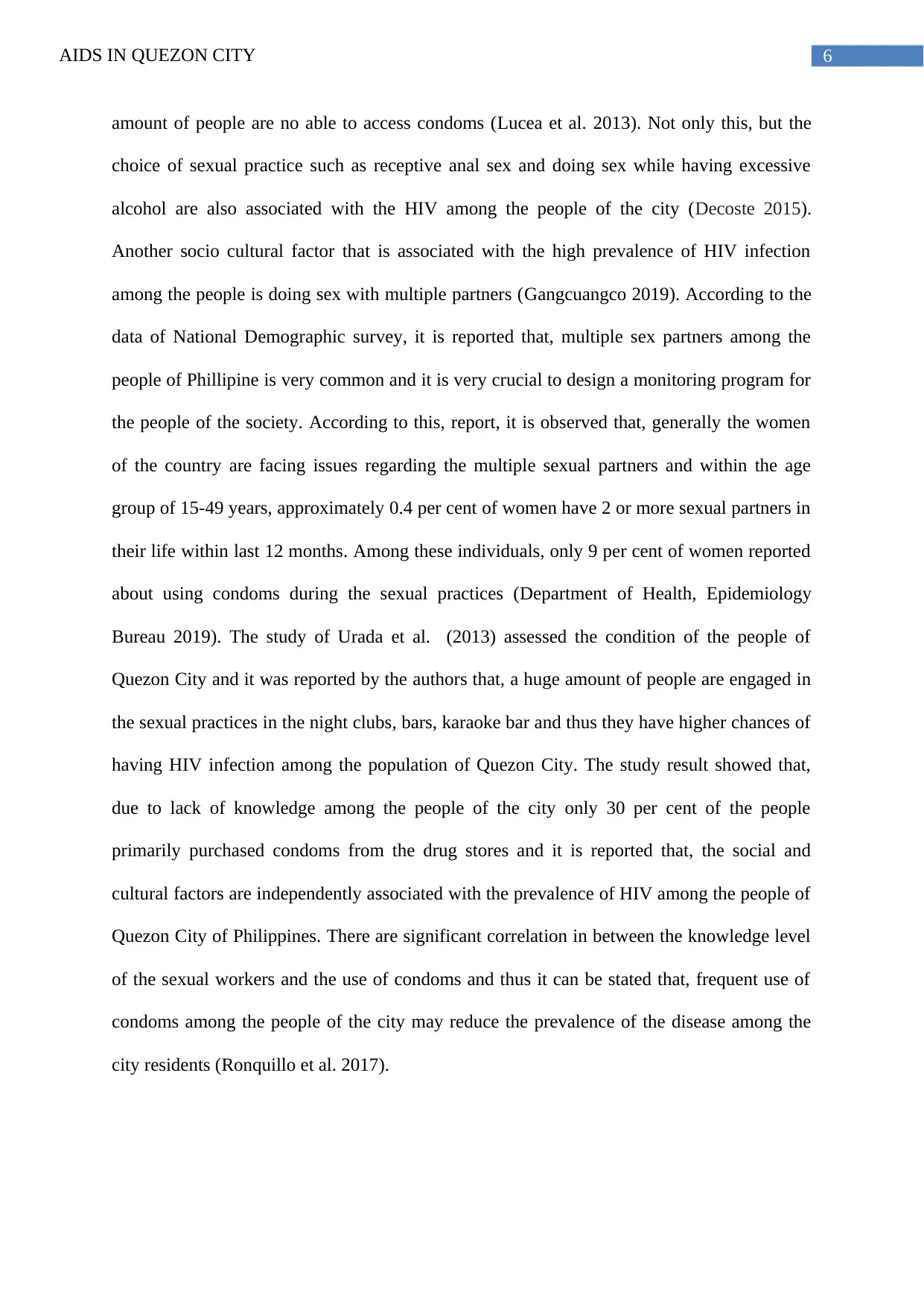
6AIDS IN QUEZON CITY
amount of people are no able to access condoms (Lucea et al. 2013). Not only this, but the
choice of sexual practice such as receptive anal sex and doing sex while having excessive
alcohol are also associated with the HIV among the people of the city (Decoste 2015).
Another socio cultural factor that is associated with the high prevalence of HIV infection
among the people is doing sex with multiple partners (Gangcuangco 2019). According to the
data of National Demographic survey, it is reported that, multiple sex partners among the
people of Phillipine is very common and it is very crucial to design a monitoring program for
the people of the society. According to this, report, it is observed that, generally the women
of the country are facing issues regarding the multiple sexual partners and within the age
group of 15-49 years, approximately 0.4 per cent of women have 2 or more sexual partners in
their life within last 12 months. Among these individuals, only 9 per cent of women reported
about using condoms during the sexual practices (Department of Health, Epidemiology
Bureau 2019). The study of Urada et al. (2013) assessed the condition of the people of
Quezon City and it was reported by the authors that, a huge amount of people are engaged in
the sexual practices in the night clubs, bars, karaoke bar and thus they have higher chances of
having HIV infection among the population of Quezon City. The study result showed that,
due to lack of knowledge among the people of the city only 30 per cent of the people
primarily purchased condoms from the drug stores and it is reported that, the social and
cultural factors are independently associated with the prevalence of HIV among the people of
Quezon City of Philippines. There are significant correlation in between the knowledge level
of the sexual workers and the use of condoms and thus it can be stated that, frequent use of
condoms among the people of the city may reduce the prevalence of the disease among the
city residents (Ronquillo et al. 2017).
amount of people are no able to access condoms (Lucea et al. 2013). Not only this, but the
choice of sexual practice such as receptive anal sex and doing sex while having excessive
alcohol are also associated with the HIV among the people of the city (Decoste 2015).
Another socio cultural factor that is associated with the high prevalence of HIV infection
among the people is doing sex with multiple partners (Gangcuangco 2019). According to the
data of National Demographic survey, it is reported that, multiple sex partners among the
people of Phillipine is very common and it is very crucial to design a monitoring program for
the people of the society. According to this, report, it is observed that, generally the women
of the country are facing issues regarding the multiple sexual partners and within the age
group of 15-49 years, approximately 0.4 per cent of women have 2 or more sexual partners in
their life within last 12 months. Among these individuals, only 9 per cent of women reported
about using condoms during the sexual practices (Department of Health, Epidemiology
Bureau 2019). The study of Urada et al. (2013) assessed the condition of the people of
Quezon City and it was reported by the authors that, a huge amount of people are engaged in
the sexual practices in the night clubs, bars, karaoke bar and thus they have higher chances of
having HIV infection among the population of Quezon City. The study result showed that,
due to lack of knowledge among the people of the city only 30 per cent of the people
primarily purchased condoms from the drug stores and it is reported that, the social and
cultural factors are independently associated with the prevalence of HIV among the people of
Quezon City of Philippines. There are significant correlation in between the knowledge level
of the sexual workers and the use of condoms and thus it can be stated that, frequent use of
condoms among the people of the city may reduce the prevalence of the disease among the
city residents (Ronquillo et al. 2017).
Paraphrase This Document
Need a fresh take? Get an instant paraphrase of this document with our AI Paraphraser
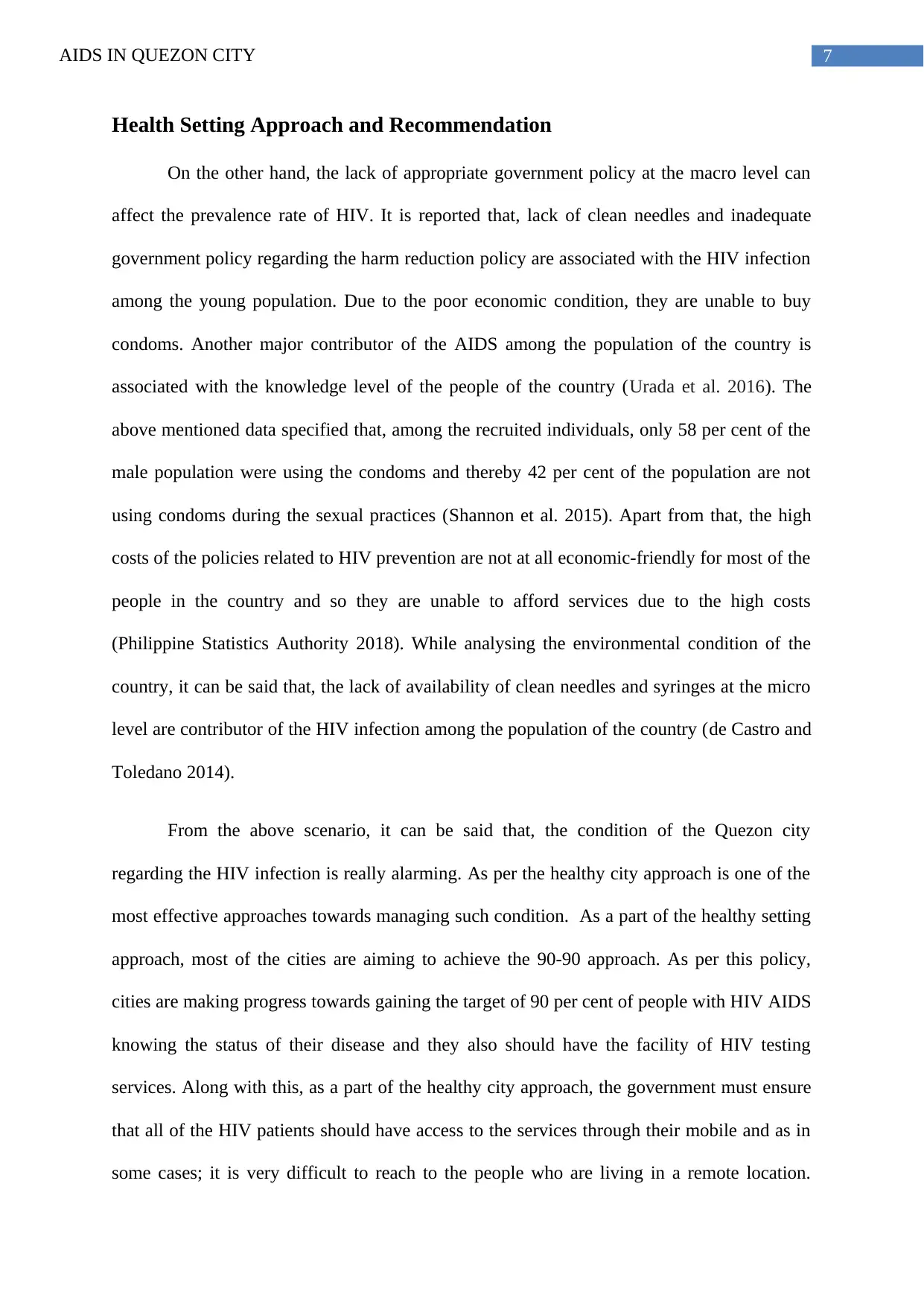
7AIDS IN QUEZON CITY
Health Setting Approach and Recommendation
On the other hand, the lack of appropriate government policy at the macro level can
affect the prevalence rate of HIV. It is reported that, lack of clean needles and inadequate
government policy regarding the harm reduction policy are associated with the HIV infection
among the young population. Due to the poor economic condition, they are unable to buy
condoms. Another major contributor of the AIDS among the population of the country is
associated with the knowledge level of the people of the country (Urada et al. 2016). The
above mentioned data specified that, among the recruited individuals, only 58 per cent of the
male population were using the condoms and thereby 42 per cent of the population are not
using condoms during the sexual practices (Shannon et al. 2015). Apart from that, the high
costs of the policies related to HIV prevention are not at all economic-friendly for most of the
people in the country and so they are unable to afford services due to the high costs
(Philippine Statistics Authority 2018). While analysing the environmental condition of the
country, it can be said that, the lack of availability of clean needles and syringes at the micro
level are contributor of the HIV infection among the population of the country (de Castro and
Toledano 2014).
From the above scenario, it can be said that, the condition of the Quezon city
regarding the HIV infection is really alarming. As per the healthy city approach is one of the
most effective approaches towards managing such condition. As a part of the healthy setting
approach, most of the cities are aiming to achieve the 90-90 approach. As per this policy,
cities are making progress towards gaining the target of 90 per cent of people with HIV AIDS
knowing the status of their disease and they also should have the facility of HIV testing
services. Along with this, as a part of the healthy city approach, the government must ensure
that all of the HIV patients should have access to the services through their mobile and as in
some cases; it is very difficult to reach to the people who are living in a remote location.
Health Setting Approach and Recommendation
On the other hand, the lack of appropriate government policy at the macro level can
affect the prevalence rate of HIV. It is reported that, lack of clean needles and inadequate
government policy regarding the harm reduction policy are associated with the HIV infection
among the young population. Due to the poor economic condition, they are unable to buy
condoms. Another major contributor of the AIDS among the population of the country is
associated with the knowledge level of the people of the country (Urada et al. 2016). The
above mentioned data specified that, among the recruited individuals, only 58 per cent of the
male population were using the condoms and thereby 42 per cent of the population are not
using condoms during the sexual practices (Shannon et al. 2015). Apart from that, the high
costs of the policies related to HIV prevention are not at all economic-friendly for most of the
people in the country and so they are unable to afford services due to the high costs
(Philippine Statistics Authority 2018). While analysing the environmental condition of the
country, it can be said that, the lack of availability of clean needles and syringes at the micro
level are contributor of the HIV infection among the population of the country (de Castro and
Toledano 2014).
From the above scenario, it can be said that, the condition of the Quezon city
regarding the HIV infection is really alarming. As per the healthy city approach is one of the
most effective approaches towards managing such condition. As a part of the healthy setting
approach, most of the cities are aiming to achieve the 90-90 approach. As per this policy,
cities are making progress towards gaining the target of 90 per cent of people with HIV AIDS
knowing the status of their disease and they also should have the facility of HIV testing
services. Along with this, as a part of the healthy city approach, the government must ensure
that all of the HIV patients should have access to the services through their mobile and as in
some cases; it is very difficult to reach to the people who are living in a remote location.
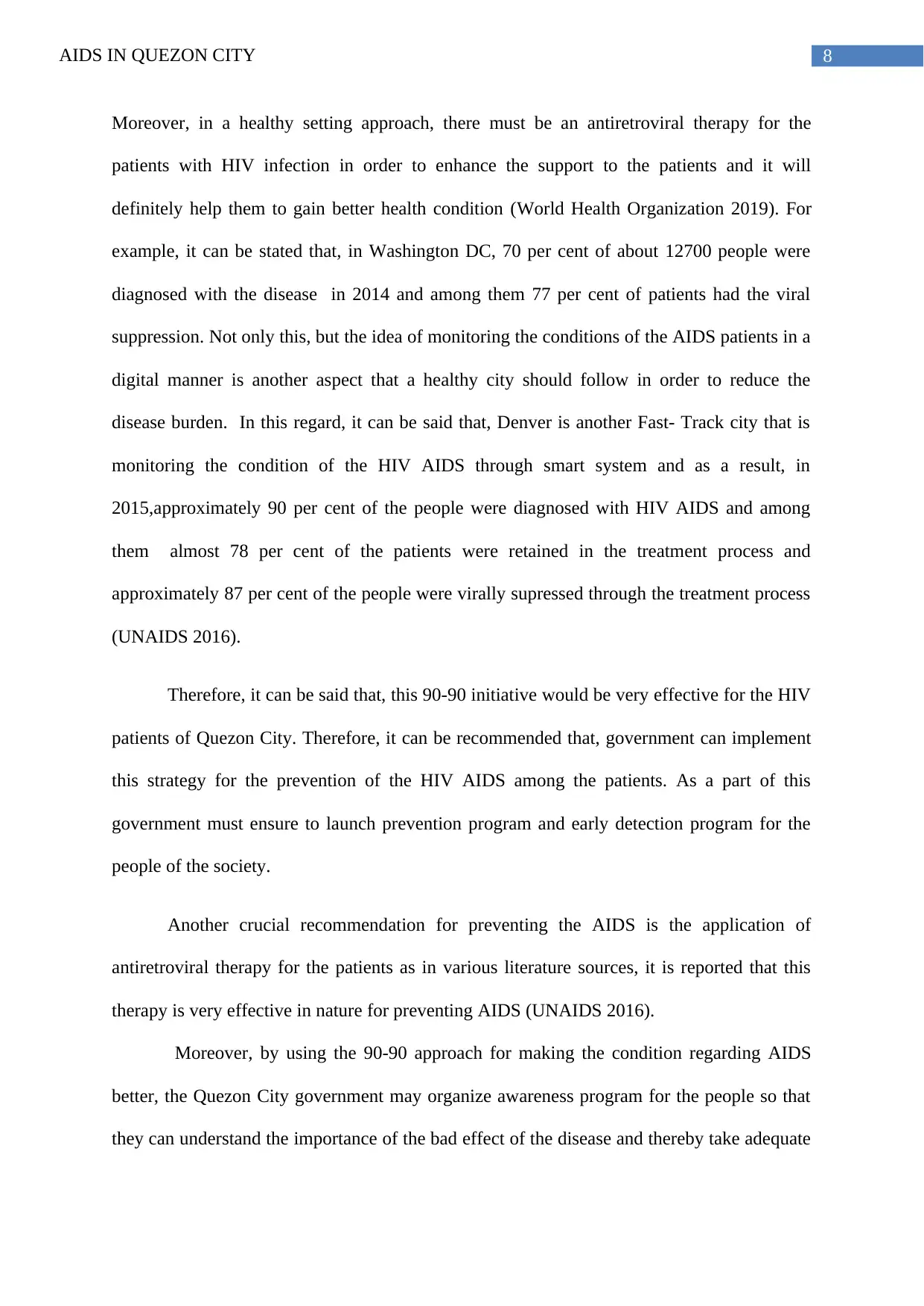
8AIDS IN QUEZON CITY
Moreover, in a healthy setting approach, there must be an antiretroviral therapy for the
patients with HIV infection in order to enhance the support to the patients and it will
definitely help them to gain better health condition (World Health Organization 2019). For
example, it can be stated that, in Washington DC, 70 per cent of about 12700 people were
diagnosed with the disease in 2014 and among them 77 per cent of patients had the viral
suppression. Not only this, but the idea of monitoring the conditions of the AIDS patients in a
digital manner is another aspect that a healthy city should follow in order to reduce the
disease burden. In this regard, it can be said that, Denver is another Fast- Track city that is
monitoring the condition of the HIV AIDS through smart system and as a result, in
2015,approximately 90 per cent of the people were diagnosed with HIV AIDS and among
them almost 78 per cent of the patients were retained in the treatment process and
approximately 87 per cent of the people were virally supressed through the treatment process
(UNAIDS 2016).
Therefore, it can be said that, this 90-90 initiative would be very effective for the HIV
patients of Quezon City. Therefore, it can be recommended that, government can implement
this strategy for the prevention of the HIV AIDS among the patients. As a part of this
government must ensure to launch prevention program and early detection program for the
people of the society.
Another crucial recommendation for preventing the AIDS is the application of
antiretroviral therapy for the patients as in various literature sources, it is reported that this
therapy is very effective in nature for preventing AIDS (UNAIDS 2016).
Moreover, by using the 90-90 approach for making the condition regarding AIDS
better, the Quezon City government may organize awareness program for the people so that
they can understand the importance of the bad effect of the disease and thereby take adequate
Moreover, in a healthy setting approach, there must be an antiretroviral therapy for the
patients with HIV infection in order to enhance the support to the patients and it will
definitely help them to gain better health condition (World Health Organization 2019). For
example, it can be stated that, in Washington DC, 70 per cent of about 12700 people were
diagnosed with the disease in 2014 and among them 77 per cent of patients had the viral
suppression. Not only this, but the idea of monitoring the conditions of the AIDS patients in a
digital manner is another aspect that a healthy city should follow in order to reduce the
disease burden. In this regard, it can be said that, Denver is another Fast- Track city that is
monitoring the condition of the HIV AIDS through smart system and as a result, in
2015,approximately 90 per cent of the people were diagnosed with HIV AIDS and among
them almost 78 per cent of the patients were retained in the treatment process and
approximately 87 per cent of the people were virally supressed through the treatment process
(UNAIDS 2016).
Therefore, it can be said that, this 90-90 initiative would be very effective for the HIV
patients of Quezon City. Therefore, it can be recommended that, government can implement
this strategy for the prevention of the HIV AIDS among the patients. As a part of this
government must ensure to launch prevention program and early detection program for the
people of the society.
Another crucial recommendation for preventing the AIDS is the application of
antiretroviral therapy for the patients as in various literature sources, it is reported that this
therapy is very effective in nature for preventing AIDS (UNAIDS 2016).
Moreover, by using the 90-90 approach for making the condition regarding AIDS
better, the Quezon City government may organize awareness program for the people so that
they can understand the importance of the bad effect of the disease and thereby take adequate
⊘ This is a preview!⊘
Do you want full access?
Subscribe today to unlock all pages.

Trusted by 1+ million students worldwide
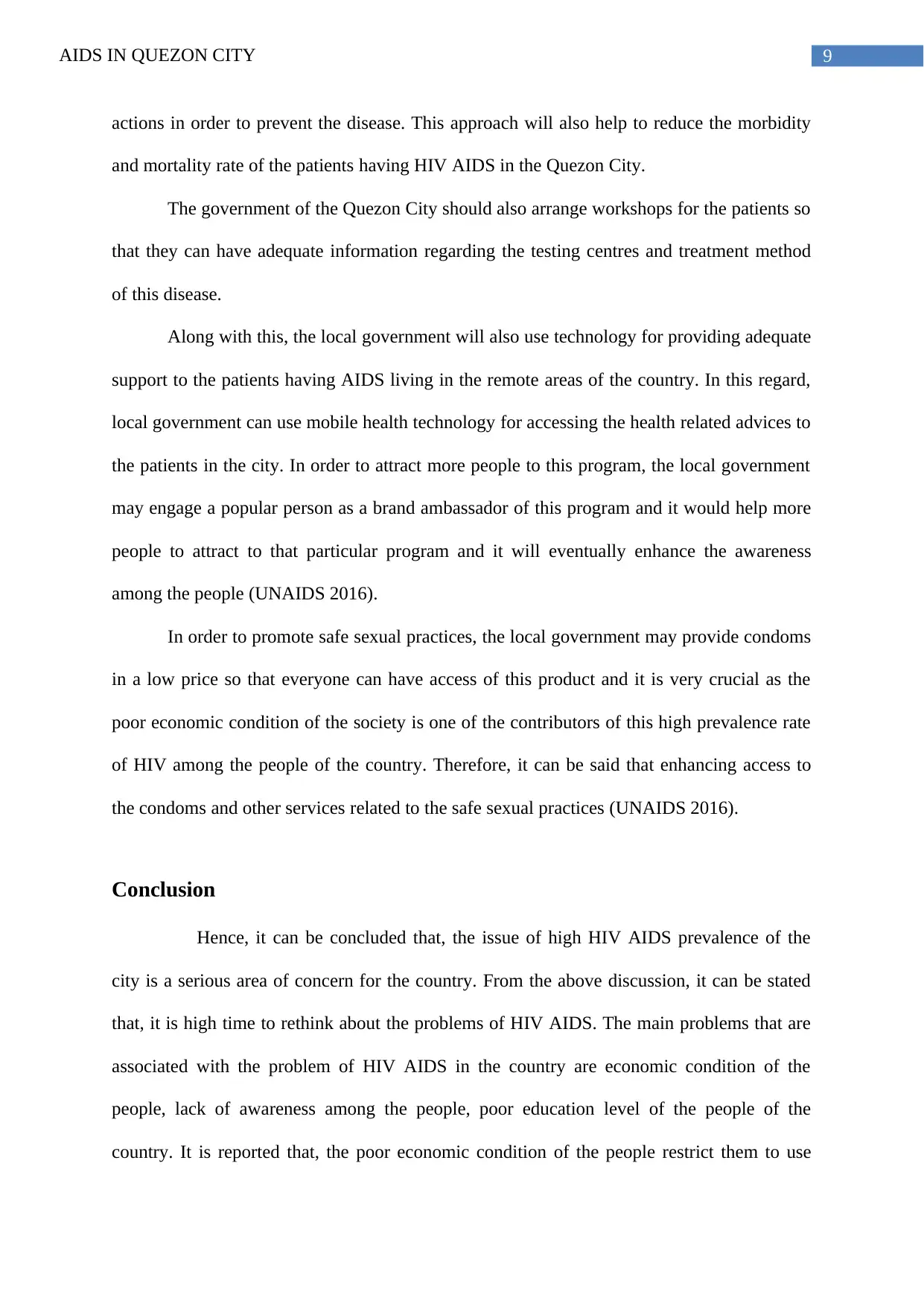
9AIDS IN QUEZON CITY
actions in order to prevent the disease. This approach will also help to reduce the morbidity
and mortality rate of the patients having HIV AIDS in the Quezon City.
The government of the Quezon City should also arrange workshops for the patients so
that they can have adequate information regarding the testing centres and treatment method
of this disease.
Along with this, the local government will also use technology for providing adequate
support to the patients having AIDS living in the remote areas of the country. In this regard,
local government can use mobile health technology for accessing the health related advices to
the patients in the city. In order to attract more people to this program, the local government
may engage a popular person as a brand ambassador of this program and it would help more
people to attract to that particular program and it will eventually enhance the awareness
among the people (UNAIDS 2016).
In order to promote safe sexual practices, the local government may provide condoms
in a low price so that everyone can have access of this product and it is very crucial as the
poor economic condition of the society is one of the contributors of this high prevalence rate
of HIV among the people of the country. Therefore, it can be said that enhancing access to
the condoms and other services related to the safe sexual practices (UNAIDS 2016).
Conclusion
Hence, it can be concluded that, the issue of high HIV AIDS prevalence of the
city is a serious area of concern for the country. From the above discussion, it can be stated
that, it is high time to rethink about the problems of HIV AIDS. The main problems that are
associated with the problem of HIV AIDS in the country are economic condition of the
people, lack of awareness among the people, poor education level of the people of the
country. It is reported that, the poor economic condition of the people restrict them to use
actions in order to prevent the disease. This approach will also help to reduce the morbidity
and mortality rate of the patients having HIV AIDS in the Quezon City.
The government of the Quezon City should also arrange workshops for the patients so
that they can have adequate information regarding the testing centres and treatment method
of this disease.
Along with this, the local government will also use technology for providing adequate
support to the patients having AIDS living in the remote areas of the country. In this regard,
local government can use mobile health technology for accessing the health related advices to
the patients in the city. In order to attract more people to this program, the local government
may engage a popular person as a brand ambassador of this program and it would help more
people to attract to that particular program and it will eventually enhance the awareness
among the people (UNAIDS 2016).
In order to promote safe sexual practices, the local government may provide condoms
in a low price so that everyone can have access of this product and it is very crucial as the
poor economic condition of the society is one of the contributors of this high prevalence rate
of HIV among the people of the country. Therefore, it can be said that enhancing access to
the condoms and other services related to the safe sexual practices (UNAIDS 2016).
Conclusion
Hence, it can be concluded that, the issue of high HIV AIDS prevalence of the
city is a serious area of concern for the country. From the above discussion, it can be stated
that, it is high time to rethink about the problems of HIV AIDS. The main problems that are
associated with the problem of HIV AIDS in the country are economic condition of the
people, lack of awareness among the people, poor education level of the people of the
country. It is reported that, the poor economic condition of the people restrict them to use
Paraphrase This Document
Need a fresh take? Get an instant paraphrase of this document with our AI Paraphraser
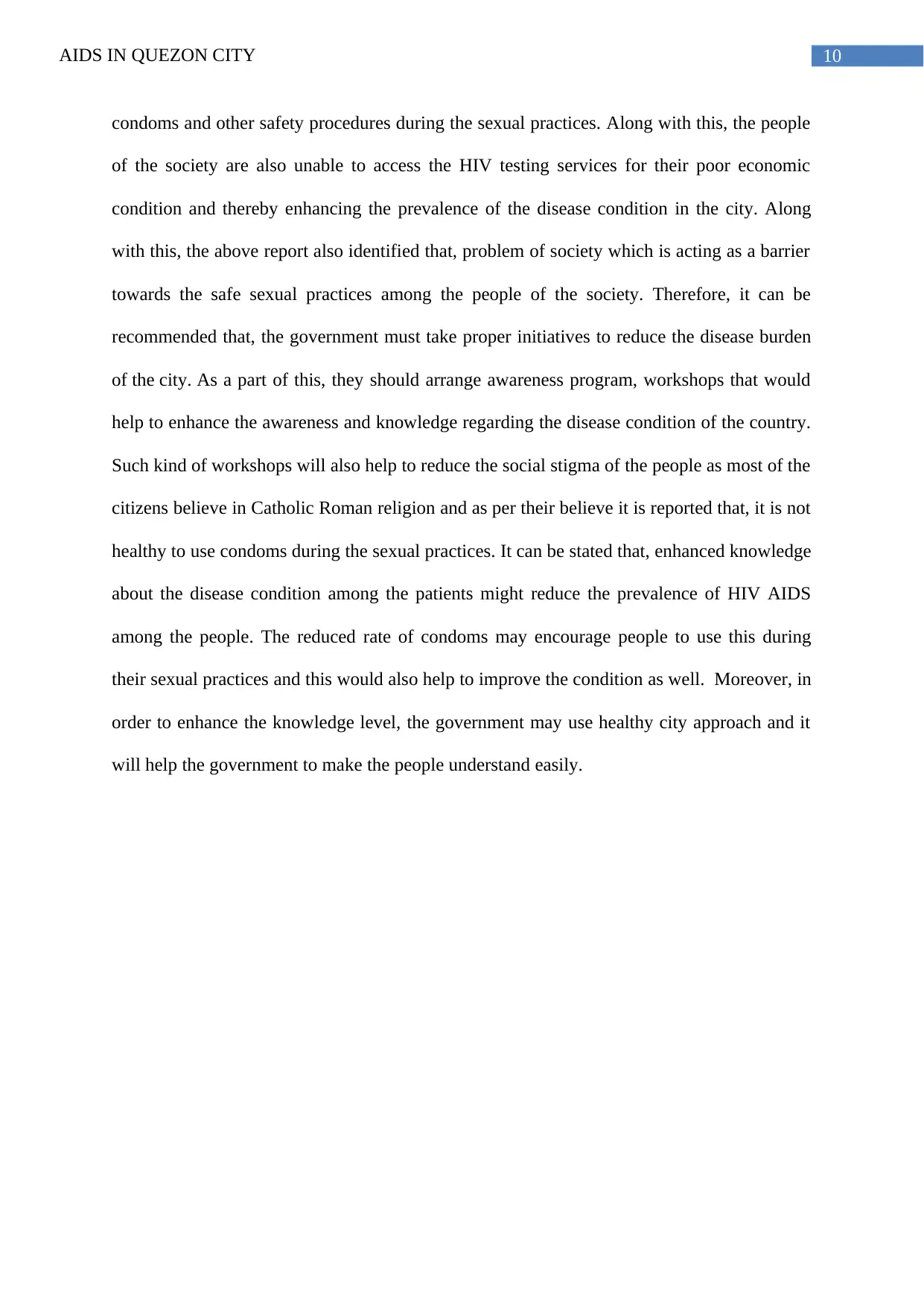
10AIDS IN QUEZON CITY
condoms and other safety procedures during the sexual practices. Along with this, the people
of the society are also unable to access the HIV testing services for their poor economic
condition and thereby enhancing the prevalence of the disease condition in the city. Along
with this, the above report also identified that, problem of society which is acting as a barrier
towards the safe sexual practices among the people of the society. Therefore, it can be
recommended that, the government must take proper initiatives to reduce the disease burden
of the city. As a part of this, they should arrange awareness program, workshops that would
help to enhance the awareness and knowledge regarding the disease condition of the country.
Such kind of workshops will also help to reduce the social stigma of the people as most of the
citizens believe in Catholic Roman religion and as per their believe it is reported that, it is not
healthy to use condoms during the sexual practices. It can be stated that, enhanced knowledge
about the disease condition among the patients might reduce the prevalence of HIV AIDS
among the people. The reduced rate of condoms may encourage people to use this during
their sexual practices and this would also help to improve the condition as well. Moreover, in
order to enhance the knowledge level, the government may use healthy city approach and it
will help the government to make the people understand easily.
condoms and other safety procedures during the sexual practices. Along with this, the people
of the society are also unable to access the HIV testing services for their poor economic
condition and thereby enhancing the prevalence of the disease condition in the city. Along
with this, the above report also identified that, problem of society which is acting as a barrier
towards the safe sexual practices among the people of the society. Therefore, it can be
recommended that, the government must take proper initiatives to reduce the disease burden
of the city. As a part of this, they should arrange awareness program, workshops that would
help to enhance the awareness and knowledge regarding the disease condition of the country.
Such kind of workshops will also help to reduce the social stigma of the people as most of the
citizens believe in Catholic Roman religion and as per their believe it is reported that, it is not
healthy to use condoms during the sexual practices. It can be stated that, enhanced knowledge
about the disease condition among the patients might reduce the prevalence of HIV AIDS
among the people. The reduced rate of condoms may encourage people to use this during
their sexual practices and this would also help to improve the condition as well. Moreover, in
order to enhance the knowledge level, the government may use healthy city approach and it
will help the government to make the people understand easily.
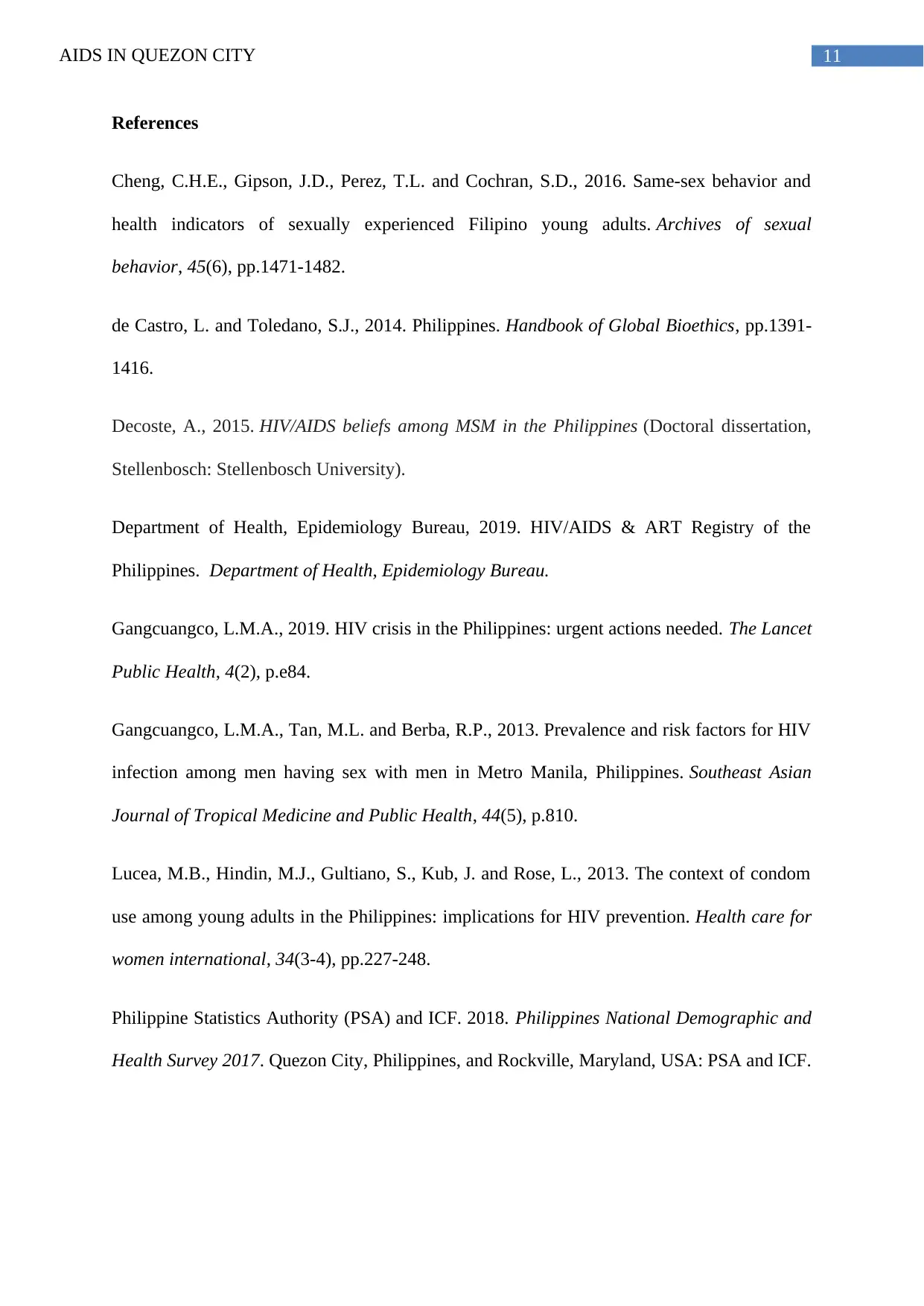
11AIDS IN QUEZON CITY
References
Cheng, C.H.E., Gipson, J.D., Perez, T.L. and Cochran, S.D., 2016. Same-sex behavior and
health indicators of sexually experienced Filipino young adults. Archives of sexual
behavior, 45(6), pp.1471-1482.
de Castro, L. and Toledano, S.J., 2014. Philippines. Handbook of Global Bioethics, pp.1391-
1416.
Decoste, A., 2015. HIV/AIDS beliefs among MSM in the Philippines (Doctoral dissertation,
Stellenbosch: Stellenbosch University).
Department of Health, Epidemiology Bureau, 2019. HIV/AIDS & ART Registry of the
Philippines. Department of Health, Epidemiology Bureau.
Gangcuangco, L.M.A., 2019. HIV crisis in the Philippines: urgent actions needed. The Lancet
Public Health, 4(2), p.e84.
Gangcuangco, L.M.A., Tan, M.L. and Berba, R.P., 2013. Prevalence and risk factors for HIV
infection among men having sex with men in Metro Manila, Philippines. Southeast Asian
Journal of Tropical Medicine and Public Health, 44(5), p.810.
Lucea, M.B., Hindin, M.J., Gultiano, S., Kub, J. and Rose, L., 2013. The context of condom
use among young adults in the Philippines: implications for HIV prevention. Health care for
women international, 34(3-4), pp.227-248.
Philippine Statistics Authority (PSA) and ICF. 2018. Philippines National Demographic and
Health Survey 2017. Quezon City, Philippines, and Rockville, Maryland, USA: PSA and ICF.
References
Cheng, C.H.E., Gipson, J.D., Perez, T.L. and Cochran, S.D., 2016. Same-sex behavior and
health indicators of sexually experienced Filipino young adults. Archives of sexual
behavior, 45(6), pp.1471-1482.
de Castro, L. and Toledano, S.J., 2014. Philippines. Handbook of Global Bioethics, pp.1391-
1416.
Decoste, A., 2015. HIV/AIDS beliefs among MSM in the Philippines (Doctoral dissertation,
Stellenbosch: Stellenbosch University).
Department of Health, Epidemiology Bureau, 2019. HIV/AIDS & ART Registry of the
Philippines. Department of Health, Epidemiology Bureau.
Gangcuangco, L.M.A., 2019. HIV crisis in the Philippines: urgent actions needed. The Lancet
Public Health, 4(2), p.e84.
Gangcuangco, L.M.A., Tan, M.L. and Berba, R.P., 2013. Prevalence and risk factors for HIV
infection among men having sex with men in Metro Manila, Philippines. Southeast Asian
Journal of Tropical Medicine and Public Health, 44(5), p.810.
Lucea, M.B., Hindin, M.J., Gultiano, S., Kub, J. and Rose, L., 2013. The context of condom
use among young adults in the Philippines: implications for HIV prevention. Health care for
women international, 34(3-4), pp.227-248.
Philippine Statistics Authority (PSA) and ICF. 2018. Philippines National Demographic and
Health Survey 2017. Quezon City, Philippines, and Rockville, Maryland, USA: PSA and ICF.
⊘ This is a preview!⊘
Do you want full access?
Subscribe today to unlock all pages.

Trusted by 1+ million students worldwide
1 out of 14
Related Documents
Your All-in-One AI-Powered Toolkit for Academic Success.
+13062052269
info@desklib.com
Available 24*7 on WhatsApp / Email
![[object Object]](/_next/static/media/star-bottom.7253800d.svg)
Unlock your academic potential
Copyright © 2020–2025 A2Z Services. All Rights Reserved. Developed and managed by ZUCOL.





